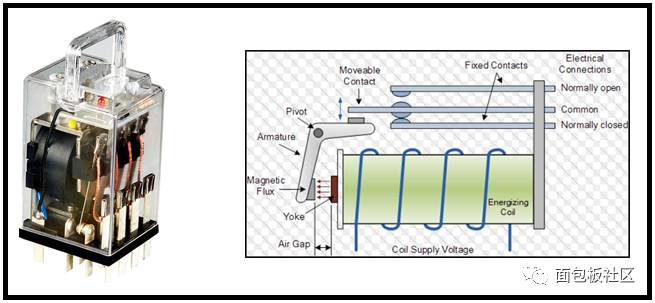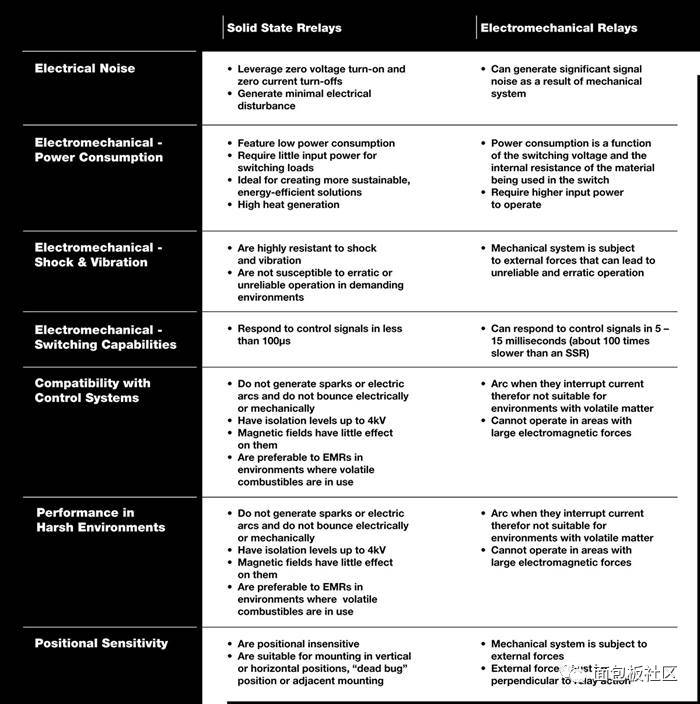Some people think that solid state relays are excellent power switch solutions, but others will think that electromechanical relays are undoubtedly the first choice. Who is right and what is the reason? To answer these questions, let's explore the differences between electromechanical relays and solid state relays, how they work, and compare their performance specifications at multiple levels.
What is a relay?Relays are power switch solutions that can be used to distribute power without the need to manually turn the switch on and off. The relay requires only a small electrical signal to turn the power on and off. To make an analogy, for a much larger electrical signal, this signal is like a "gatekeeper." The ability to perform low-power control of high-power signals has made relays a prominent player in the evolution of electronics.
What is the difference between electromechanical relays and solid state relays?Electromechanical Relay (EMR)
Electromechanical relays use physical moving parts to connect the contacts in the relay output components. The movement of this contact is generated using electromagnetic force from a low power input signal, allowing the circuit containing the high power signal to complete. Physical components in electromechanical relays typically emit a "click" sound that can be useful in some situations, but it can cause internal arcing and, relatively speaking, movement can take a significant amount of time.
Solid state relay (SSR)
Solid state relays may be the typical representative of the semiconductor industry. The SSR uses a low-power electrical signal to produce an optical semiconductor signal that typically includes an optocoupler that is used to transmit and power the output signal. When activated, the output optical signal acts as a "switch" that allows high-power signals to pass through the output components of the SSR. There are several ways to do this, but the common theme is the lack of moving parts, so let them become solid.

Figure 1 – A typical electromechanical relay (EMR) and a block diagram of the EMR describing its moving parts.

Figure 2 – Panel Mount Solid State Relay – Diagram from Crydom and showing the phototransistor mechanism. The illustration is provided by Wikipedia.
Both technologies can be used in areas such as heating, lighting and motion control. However, solid state relays are superior to electromechanical relays in most of the comparative categories. Electromechanical relays are a relatively old technology with simple mechanical design methods, while solid state relays are relatively new and advanced, and, of course, more complex. I am afraid some people will say that to accomplish the same task, complicated things are not necessarily better than simple products. However, a more complex SSR is the ability to win people's support in performance.
What are the advantages of using solid state relays compared to electromechanical relays?Compared with electromechanical relays, the prepaid price of solid state relays is very high, even amazingly high. However, the overall cost of integrating SSRs in place of EMR may be the same or even lower, depending on the application, which we will discuss later. In addition, SSRs typically outperform EMR in many areas. Let's compare the two:

As you can see, SSRs are generally more dynamic in terms of performance and functionality than EMR. But in a certain field, EMR often has an advantage: thermal management. Due to their physical characteristics, the power dissipation of the SSR is orders of magnitude greater than that of electromechanical relays. This usually means that component designers must integrate heat sinks and fans into their designs, which does increase the overall upfront cost of using SSR.
Before you give up on SSR simply because of the upfront cost, let's talk about the total cost of ownership and the individuals who ensure the true meaning of “costâ€.
Comparison cost: Why SSR is worthwhile in the long runEngineers usually focus on performance, and better performance often means higher costs. On the other hand, supply chain managers are more concerned with the initial pricing and delivery time of components, which are called procurement costs. Business and marketing managers focus on warranty costs, such as life expectancy and associated maintenance costs, consisting of downtime, travel time, replacement and repair time, and human resources. Of all these costs, only the initial pricing of the parts can be equated with the “one-time upfront prepaid cost†mentioned earlier.
However, just because electromechanical relays have a lower initial price tag, considering the sum of all other hidden costs in the future does not mean that they are less expensive. In today's enterprises, managers often demand faster “better and cheaper†solutions, which are often a competing priority, but cheaper does not necessarily mean faster and/or better. However, considering the total cost of ownership, with Crydom solid state relays and contactors, you can achieve faster, better, and cheaper. Their solid-state relays reliably implement solutions that ensure the life of the application, so after installation, you rarely need to worry about maintaining, repairing, or replacing them.
Useful tools to compare total cost of ownership
To help analyze the total cost of ownership (TCO) of SSR versus EMR, Crydom has developed an easy-to-use TCO calculator that can be found under the Tools tab on its website. The calculator takes into account information related to direct and indirect costs, and also assumes that both power switch solutions are selected to match the load and power system. In addition, the calculator incorporates major technology-related costs, as these costs are common in a variety of applications.
The unit cost of the calculator is the acquisition cost of the power switch solution. There are also acquisition costs for adding heat sinks (for SSR) and sockets (for EMR), if one of the two is needed in the application. Life expectancy measured by the number of cycles or the number of runs is also taken into account, as they are specific requirements for a given application. This may include the expected number of cycles per minute or the type of load (such as resistors, inductors, transformers/capacitors, or ballasts).
For EMR, the estimated life expectancy needs to be adjusted according to the type of load. The calculator can automatically select the appropriate derating value based on the selected load: 80% derating for the motor, coil or solenoid; 75% derating for the transformer or capacitor The ballast is 70% derated. A warranty period is also included in the calculation for a time reference for the total cost estimate. The warranty period can be adjusted to show different time ranges, from one month to one year or longer. The cost of each maintenance service must take into account another variable as it changes between different applications or from one business model to another. Figure 3 shows Crydom's TCO calculator.

Figure 3 - Crydom's TCO Calculator.
When you choose between electromechanical relay technology and solid state technology, it may be difficult to adapt to the upfront cost of SSR. However, although the initial cost of the EMR is less than the SSR, as the cycle count increases, the cost of maintenance, repair, and/or replacement of the EMR increases. So, once you manage to overcome the total cost of ownership barriers of SSR and EMR, you quickly realize that the life cost of an SSR is, in many cases, equal to or less than the EMR. Since SSRs outperform EMR in terms of both functionality and performance, it's not difficult to decide to integrate SSR into your design.
Guangzhou Lufeng Electronic Technology Co. , Ltd. , https://www.lufengelectronics.com